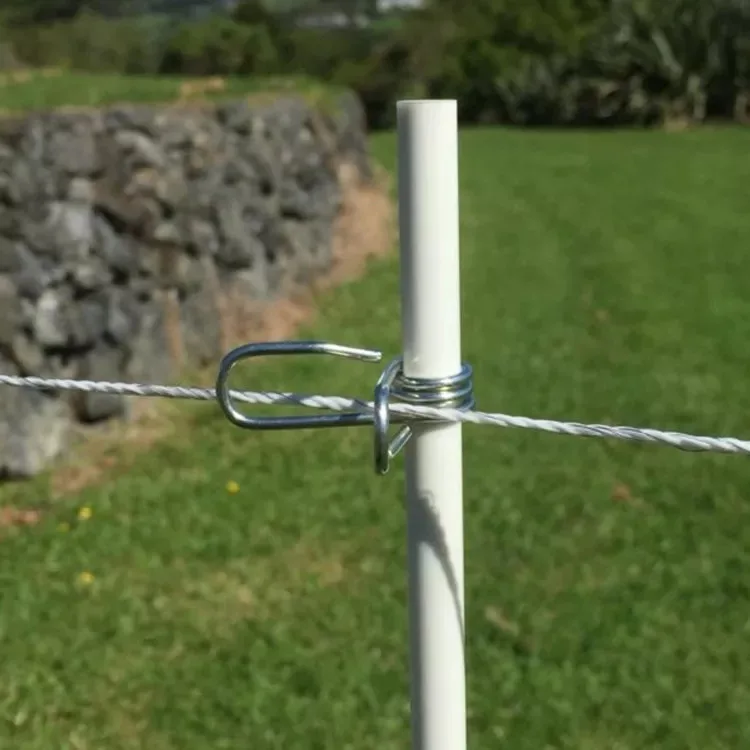Introduction
Wood stakes warp, steel posts rust, yet industrial sites still rely on them, often because teams assume anything else will cost more up‑front. A fiberglass fence stake changes that math: pultruded glass‑fiber profiles deliver lighter handling, zero corrosion, and decades of service life, delivering lower total installed cost for utilities, civil contractors, and agricultural operations.
“We switched to composites after losing an entire perimeter line to coastal corrosion in under four years,” notes the maintenance superintendent of a Middle‑East desalination plant (name withheld for confidentiality).
Unicomposite, an ISO‑certified pultrusion manufacturer, produces standard and custom FRP stakes at its own facility in China, supporting bulk buyers with engineering assistance, batch traceability, and global logistics.

fiberglass fence stake
Why Material Choice Matters in Industrial Fencing Projects
Total Cost of Ownership Over a 10‑Year Service Life
A 2024 meta‑study across 19 utilities found replacement, coating, and downtime push the 10‑year cost of galvanized‑steel posts 42 % higher than a fiberglass alternative at equal footage. Wood fared worse, requiring replacement every 3‑5 years in high‑humidity regions. When budgeting large installations, purchasing teams should multiply the unit price by the expected service life, not by linear foot alone.
Safety & Compliance: Dielectric Performance, Non‑Sparking, Corrosion Resistance
Fiberglass is inherently non‑conductive—ASTM D149 dielectric strength > 300 kV/cm—making it the preferred stake near energized equipment or electrified animal fencing. It does not spark against metal tools, and its resistance to acids, salts, and fertilizers satisfies OSHA and EPA guidelines for chemical‑exposed facilities.
Performance Comparison: Fiberglass vs. Wood vs. Steel Fence Stakes
Strength‑to‑Weight Ratio and Load Capacity Data
| Property (typical) | Fiberglass Stake | Treated Pine | Galvanized Steel |
|---|---|---|---|
| Density (lb/ft³) | 105 | 35 | 490 |
| Flexural Strength (psi) | 100,000 | 8,000 | 58,000 |
| Specific Strength* | 952 | 229 | 118 |
| *Flexural strength divided by density. |
A pultruded fiberglass fence stake can weigh 65 % less than steel yet carry higher lateral load before permanent deflection. That lets installers transport 400 stakes in a pickup bed instead of hiring a flatbed.
Resistance to Rot, Rust, Chemicals, and UV Degradation
Wood: vulnerable to fungi; preservatives leach, raising environmental concerns.
Steel: zinc coating scratches during driving; coastal chloride exposure accelerates pitting.
Fiberglass: glass fibers are inert; UV‑stable resins and surfacing veils provide 20‑year color retention with no painting.
Field Case Study: Coastal Waste‑Water Lagoon Perimeter
An anonymized municipal utility on the U.S. Gulf Coast replaced 1,600 corroded steel posts with FRP stakes in 2021. After Hurricane Idalia (2023), structural inspections recorded 0 failures and < 3 % cosmetic resin crazing—compared with 12 % outright loss in adjacent untreated‑wood partitions. Maintenance budget for that fence line dropped from USD 21,000/yr to USD 3,200/yr (mostly vegetation trimming).
Installation & Maintenance Efficiencies
Lightweight Handling for Faster Crew Productivity
At 1.9 lb for a 6‑ft profile, a fiberglass stake can be carried in bundles of 25 by one worker, reducing labor hours by up to 35 % on large projects. Crews also report less fatigue, cutting OSHA recordable incidents linked to over‑exertion.
Zero‑Maintenance Surface—No Painting, No Galvanizing, No Rot Treatments
Once in the ground, FRP requires nothing beyond occasional rinsing. That frees facility teams to focus on core operations instead of scraping rust or applying copper‑naphthenate. Unicomposite offers color‑integrated resin systems (safety yellow, olive, custom RAL) so appearance lasts as long as the structure itself.
Sustainability & ESG Impact
Life‑Cycle Carbon Footprint and Potential LEED Contribution
According to the 2023 European Composite Industry Report, pultruded fiberglass posts generate 35 % less embodied CO₂ than hot‑dip‑galvanized steel when normalized for equal stiffness. Because they last longer, the impact per year of use is even lower, important for clients reporting Scope 3 emissions. Projects targeting LEED v4 may claim Material & Resources credits by demonstrating extended lifespan and reduced maintenance chemicals.
End‑of‑Life Recycling and Re‑Grinding Options
Off‑cut and retired stakes can be re‑ground into filler for concrete or asphalt, or sent to cement kilns as silica‑rich fuel supplement. Several European recyclers offer take‑back programs, and Unicomposite can coordinate container returns upon request.
Partnering with an Experienced Pultrusion Manufacturer
Custom Profiles, Colors, and Hardware Integration—Engineering Support from Unicomposite
Need a triangular cross‑section for anti‑climb security? Integrated cable‑routing notches? Unicomposite’s design team uses finite‑element modeling to tailor glass orientation, wall thickness, and resin blend for each application. Customers receive tabulated mechanical data, salt‑spray test results, and prototypes within three weeks.
ISO Quality Control, Batch Traceability, and Global Logistics Capability
Every fiberglass fence stake ships with an ISO 9001 batch number, cure log, and resin lot traceability. Palletized shipments depart Ningbo or Shanghai weekly, and Unicomposite’s export desk manages paperwork from SGS inspection to arrival at your regional warehouse.
Conclusion
Switching from wood or steel to a fiberglass fence stake delivers measurable ROI: lighter handling, longer service life, superior safety, and documented sustainability gains. Unicomposite’s ISO‑certified pultrusion lines and engineering support make the transition seamless. Ready to reduce your fence life‑cycle cost? Request a technical data sheet or personalized quote today.
Frequently Asked Questions
Q1. Can fiberglass stakes be driven with standard post pounders?
Yes. Use a rubber‑faced cap or driving sleeve to protect the stake head; pneumatic and manual pounders work without modifications.
Q2. Do FRP stakes require grounding near electrical equipment?
No grounding is needed. Fiberglass is non‑conductive, so it will not create unintended paths for current.
Q3. How tall can a fiberglass fence stake be without cross‑bracing?
For typical security fencing, 8‑ft stakes in 50 mm × 50 mm square profile handle 90 mph wind loads unbraced; taller heights may require engineered spacing or ribbed sections.
Q4. Are color options limited to safety yellow?
Unicomposite can match any RAL number during pultrusion, embedding pigment into the resin for fade‑resistant color throughout the profile.
Q5. What is the typical lead time for a 5,000‑piece order?
Standard profiles ship in 3–4 weeks after receipt of purchase order; custom geometries may extend lead time by one additional week for tooling.
 info@unicomposite.com
info@unicomposite.com


























